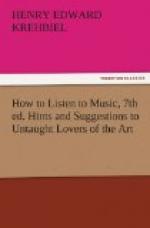This relation has been more than reversed since then, the orchestras at modern oratorio performances seldom being one-fifth as large as the choir. This difference, however, is due largely to the changed character of modern music, that of to-day treating the instruments as independent agents of expression instead of using them chiefly to support the voices and add sonority to the tonal mass, as was done by Handel and most of the composers of his day.
[Sidenote: Glee unions and male choirs.]
I omit from consideration the Glee Unions of England, and the quartets, which correspond to them, in this country. They are not cultivators of choral music, and the music which they sing is an insignificant factor in culture. The male choirs, too, need not detain us long, since it may be said without injustice that their mission is more social than artistic. In these choirs the subdivision into parts is, as a rule, into two tenor voices, first and second, and two bass, first and second. In the glee unions, the effect of whose singing is fairly well imitated by the college clubs of the United States (pitiful things, indeed, from an artistic point of view), there is a survival of an old element in the male alto singing above the melody voice, generally in a painful falsetto. This abomination is unknown to the German part-songs for men’s voices, which are written normally, but are in the long run monotonous in color for want of the variety in timbre and register which the female voices contribute in a mixed choir.
[Sidenote: Women’s choirs.]
There are choirs also composed exclusively of women, but they are even more unsatisfactory than the male choirs, for the reason that the absence of the bass voice leaves their harmony without sufficient foundation. Generally, music for these choirs is written for three parts, two sopranos and contralto, with the result that it hovers, suspended like Mahomet’s coffin, between heaven and earth. When a fourth part is added it is a second contralto, which is generally carried down to the tones that are hollow and unnatural.
[Sidenote: Boys’ choirs.]
The substitution of boys for women in Episcopal Church choirs has grown extensively within the last ten years in the United States, very much to the promotion of aesthetic sentimentality in the congregations, but without improving the character of worship-music. Boys’ voices are practically limitless in an upward direction, and are naturally clear and penetrating. Ravishing effects can be produced with them, but it is false art to use passionless voices in music conceived for the mature and emotional voices of adults; and very little of the old English Cathedral music, written for choirs of boys and men, is preserved in the service lists to-day.
[Sidenote: Mixed choirs.]




